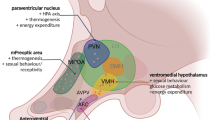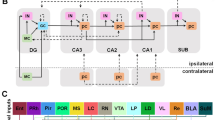Abstract
The possible involvement of the ascending 5-hydroxytryptaminergic (5HTergic) pathways in the maintenance of operant behaviour by positive reinforcement was examined using a quantitative paradigm based on Herrnstein's (1970) equation which defines a hyperbolic relationship between steady-state response rate and reinforcement frequency in variable-interval schedules. Nine rats received injections of 5,7-dihydroxytryptamine into the dorsal and median raphe nuclei; 12 rats received sham injections. The rats were trained to steady-state in a series of variable-interval schedules of sucrose reinforcement affording a range of reinforcement frequencies. Herrnstein's equation was fitted to the data obtained from each rat and to the averaged data obtained from the two groups. The value of KH (the parameter expressing the reinforcement frequency needed to obtain the half-maximum response rate) was significantly lower in the lesioned group than in the control group; the values of Rmax (the parameter expressing the maximum response rate) did not differ significantly between the two groups. The levels of 5HT and 5-hydroxyindoleacetic acid in the parietal cortex, hippocampus, nucleus accumbens and hypothalamus were markedly reduced in all four regions in the lesioned group, but the levels of noradrenaline and dopamine were not significantly affected. The results indicate that damage to the central 5HTergic pathways resulted in an increase in the “value” of the sucrose reinforcer, without affecting the animals' response capacity. The results are consistent with the suggestion that the 5HTergic pathways may exert some limiting control on the “values” of certain reinforcers.
Similar content being viewed by others
References
Alsop B, Elliffe D (1988) Concurrent-schedule performance: effects of relative and overall reinforcer rate. J Exp Anal Behav 49:21–36
Baumgarten HG, Jenner S, Bjorklund A, Klemm HP, Schlossberger HG (1982) Serotonin neurotoxins. In: Osborne NN (ed) Biology of serotonergic transmission. Wiley, Chichester
Bevan P, Cools AR, Archer T (1989) (eds) Behavioural pharmacology of 5HT. Erlbaum, Hillsdale NJ
Blundell NE (1977) Is there a role for serotonin (5-hydroxytryptamine) in feeding. Int J Obes 1:15–42
Bradshaw CM, Szabadi E (1988) Quantitative analysis of human operant behaviour. In: Davey GCL, Cullen, C (eds) Human operant conditioning and behavior modification. Wiley, Chichester
Bradshaw CM, Szabadi E (1989) Central neurotransmitter systems and the control of operant behaviour by “natural” positive reinforcers. In: Liebman JH, Cooper SJ (eds) The neuropharmacological basis of reward. Oxford University Press, New York
Bradshaw CM, Szabadi E, Bevan P (1976) Behavior of humans in variable-interval schedules of reinforcement. J Exp Anal Behav 26:135–141
Bradshaw CM, Ruddle HV, Szabadi E (1981) Relationship between response rate and reinforcement frequency in variable-interval schedules; II. Effect of the volume of sucrose reinforcement. J Exp Anal Behav 35:263–269
Bradshaw CM, Szabadi E, Ruddle HV (1983a) Herrnstein's equation: effect of response force on performance in variable-interval schedules. Behav Anal Lett 3:93–100
Bradshaw CM, Szabadi E, Ruddle HV, Pears E (1983b) Herrnstein's equation: effect of deprivation level on performance in variable-interval schedules. Behav Anal Lett 3:267–273
Catania AC, Reynolds GS (1968) A quantitative analysis of the responding maintained by interval schedules of reinforcement. J Exp Anal Behav 11:327–383
Cooper SJ, Neill JC (1987) 5HT receptors and the sweet tooth. TIPS 8:199
Davison MC (1969) Successive interresponse times in fixed-ratio and second-order fixed-ratio performance. J Exp Anal Behav 12:385–389
Deakin JFW (1983) Roles of serotonergic systems in escape, avoidance and other behaviours. In: Cooper SJ (ed) Theory in psychopharmacology, vol 2. Academic Press, New York
Dourish CT, Clark ML, Fletcher A, Iversen SD (1989) Evidence that blockade of post-synaptic 5HT1 receptors elicits feeding in satiated rats. Psychopharmacology 97:54–58
Goudie AJ, Thornton EW, Wheeler TJ (1976) Effects of Lilly 110140, a specific inhibitor of 5-hydroxytryptamine uptake, on food intake and 5-hydroxytryptophan-induced anorexia: evidence for serotonergic inhibition of feeding. J Pharm Pharmacol 28:318–320
Graeff FG (1974) Tryptamine antagonists and punished behavior. J Pharmacol Exp Ther 189:344–350
Gray JA (1982) Precis of “The neuropsychology of anxiety: an enquiry into the functions of the septo-hippocampal system”. Behav Brain Sci 5:469–534
Hamilton AL, Stellar JR, Hart EB (1985) Reward, performance, and the response strength method in self-stimulating rats: validation and neuroleptics. Physiol Behav 35:897–904
Herrnstein RJ (1970) On the law of effect. J Exp Anal Behav 13:243–266
Herrnstein RJ (1974) Formal properties of the matching law. J Exp Anal Behav 21:159–164
Heyman GM, Monaghan MM (1987) The effect of changes in the response requirement and deprivation on the parameters of the matching law equation: new data and review. J Exp Psychol [Anim Behav Proc] 13:384–394
Hoebel BG, Zemlam FP, Trulson ME, Mackenzie RG, Ducret RP, Norelli C (1978) Differential effects of p-chlorophenylalanine and 5,7-dihydroxytryptamine on feeding in rats. Ann NY Acad Sci 305:590–594
Leccese AP, Lyness WH (1984) The effects of putative 5-hydroxytryptamine receptor active agents on D-amphetamine self-administration in controls and rats with 5, 7-dihydroxytryptamine median forebrain bundle lesions. Brain Res 303:153–162
Lewis D (1960) Quantitative methods in psychology. Springer, Berlin Heidelberg New York
Lyness WH, Friedle NM, Moore KE (1980) Increased self-administration of D-amphetamine after destruction of 5-hydroxytryptaminergic nerves. Pharmacol Biochem Behav 12:937–941
McDowell JJ (1981) Wilkinson's method of estimating the parameters of Herrnstein's equation. J Exp Anal Behav 35:413–414
Morley MJ, Bradshaw CM, Szabadi E (1984) The effects of pimozide on variable-interval performance: a test of the anhedonia hypothesis of the mode of action of neuroleptics. Psychopharmacology 84:531–536
Morley MJ, Bradshaw CM, Szabadi E (1987) Effect of 6-hydroxydopamine-induced lesions of the dorsal noradrenergic bundle on steady-state operant behaviour. Psychopharmacology 93:520–525
Morley MJ, Shah K, Bradshaw CM, Szabadi E (1988) DSP4 and Herrnstein's equation: further evidence for a role of noradrenaline in the maintenance of operant behaviour by positive reinforcement. Psychopharmacology 96:551–556
Neill JC, Cooper SJ (1988) Evidence for serotonergic modulation of sucrose sham-feeding in the gastric-fistulated rat. Physiol Behav 44:453–459
Ogren S-O (1985) Central serotonin neurones in avoidance learning: interactions with noradrenaline and dopamine neurones. Pharmacol Biochem Behav 23:107–123
Owen JE (1963) Psychopharmacological studies of some 1(chlorophenyl)-2-aminopropanes. I: Effects on appetitecontrolled behaviours. J Pharm Sci 52:679–683
Paxinos G, Watson C (1982) The rat brain in stereotaxic coordinates. Academic Press, New York
Samanin R (1989) Serotonin and feeding. In: Bevan P, Cools AR, Archer T (eds) Behavioural pharmacology of 5HT. Erlbaum, Hillsdale, NJ
Soubrie P (1986) Reconciling the role of central serotonin neurons in human and animal behavior. Behav Brain Sci 9:319–364
Wilkinson GN (1961) Statistical estimations in enzyme kinetics. Biochem J 80:324–332
Willner P, McGuirk J, Phillips G, Muscat R (1990) Behavioural analysis of the anorectic effects of fluoxetine and fenfluramine. Psychopharmacology 102:273–277
Author information
Authors and Affiliations
Rights and permissions
About this article
Cite this article
Wogar, M.A., Bradshaw, C.M. & Szabadi, E. Evidence for an involvement of 5-hydroxytryptaminergic neurones in the maintenance of operant behaviour by positive reinforcement. Psychopharmacology 105, 119–124 (1991). https://doi.org/10.1007/BF02316873
Received:
Revised:
Issue Date:
DOI: https://doi.org/10.1007/BF02316873




